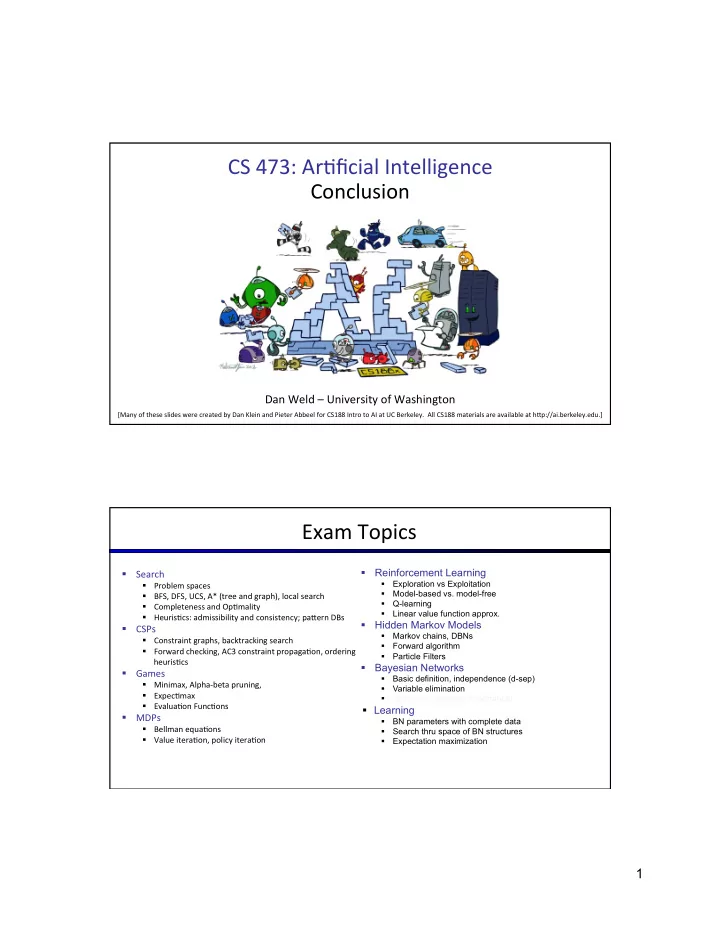

CS ¡473: ¡Ar*ficial ¡Intelligence ¡ Conclusion ¡ ¡ Dan ¡Weld ¡– ¡University ¡of ¡Washington ¡ [Many ¡of ¡these ¡slides ¡were ¡created ¡by ¡Dan ¡Klein ¡and ¡Pieter ¡Abbeel ¡for ¡CS188 ¡Intro ¡to ¡AI ¡at ¡UC ¡Berkeley. ¡ ¡All ¡CS188 ¡materials ¡are ¡available ¡at ¡hMp://ai.berkeley.edu.] ¡ Exam ¡Topics ¡ § Reinforcement Learning § Search ¡ § Exploration vs Exploitation § Problem ¡spaces ¡ § Model-based vs. model-free § BFS, ¡DFS, ¡UCS, ¡A* ¡(tree ¡and ¡graph), ¡local ¡search ¡ § Q-learning § Completeness ¡and ¡Op*mality ¡ § Linear value function approx. § Heuris*cs: ¡admissibility ¡and ¡consistency; ¡paMern ¡DBs ¡ § Hidden Markov Models § CSPs ¡ § Markov chains, DBNs § Constraint ¡graphs, ¡backtracking ¡search ¡ Forward algorithm § § Forward ¡checking, ¡AC3 ¡constraint ¡propaga*on, ¡ordering ¡ § Particle Filters heuris*cs ¡ § Bayesian Networks § Games ¡ § Basic definition, independence (d-sep) § Minimax, ¡Alpha-‑beta ¡pruning, ¡ ¡ § Variable elimination § Expec*max ¡ § Sampling (rejection, importance) § Evalua*on ¡Func*ons ¡ § Learning § MDPs ¡ § BN parameters with complete data § Bellman ¡equa*ons ¡ § Search thru space of BN structures § Value ¡itera*on, ¡policy ¡itera*on ¡ Expectation maximization § 1
What ¡is ¡intelligence? ¡ § (bounded) ¡Ra*onality ¡ § Agent ¡has ¡a ¡performance ¡measure ¡to ¡op*mize ¡ § Given ¡its ¡state ¡of ¡knowledge ¡ § Choose ¡op*mal ¡ac*on ¡ ¡ § With ¡limited ¡computa*onal ¡resources ¡ § Human-‑like ¡intelligence/behavior ¡ Search ¡in ¡Discrete ¡State ¡Spaces ¡ § Every ¡discrete ¡problem ¡can ¡be ¡cast ¡as ¡a ¡search ¡problem. ¡ § states, ¡ac*ons, ¡transi*ons, ¡cost, ¡goal-‑test ¡ § Types ¡ § uninformed ¡systema*c: ¡ocen ¡slow ¡ § DFS, ¡BFS, ¡uniform-‑cost, ¡itera*ve ¡deepening ¡ § Heuris*c-‑guided: ¡beMer ¡ § Greedy ¡best ¡first, ¡A* ¡ § relaxa*on ¡leads ¡to ¡heuris*cs ¡ § Local: ¡fast, ¡fewer ¡guarantees; ¡ocen ¡local ¡op*mal ¡ § Hill ¡climbing ¡and ¡varia*ons ¡ § Simulated ¡Annealing: ¡global ¡op*mal ¡ § (Local) ¡Beam ¡Search ¡ 2
Which ¡Algorithm? ¡ § A*, Manhattan Heuristic: Adversarial ¡Search ¡ 3
Adversarial ¡Search ¡ § AND/OR ¡search ¡space ¡(max, ¡min) ¡ § minimax ¡objec*ve ¡func*on ¡ § minimax ¡algorithm ¡(~dfs) ¡ § alpha-‑beta ¡pruning ¡ § U*lity ¡func*on ¡for ¡par*al ¡search ¡ § Learning ¡u*lity ¡func*ons ¡by ¡playing ¡with ¡itself ¡ § Openings/Endgame ¡databases ¡ Knowledge ¡Representa*on ¡and ¡Reasoning ¡ § Represen*ng: ¡what ¡agent ¡knows ¡ Propositional logic Constraint networks HMMs Bayesian networks … § Reasoning: ¡what ¡agent ¡can ¡infer ¡ ¡ Search Dynamic programming Preprocessing to simplify 4
Search+KR&R ¡Example: ¡CSP ¡ § Representa*on ¡ ¡ § Variables, ¡Domains, ¡Constraints ¡ § Reasoning: ¡ § Arc ¡Consistency ¡(k-‑Consistency) ¡ § Solving ¡ § Backtracking ¡search: ¡par*al ¡var ¡assignments ¡ § Heuris*cs: ¡min ¡remaining ¡values, ¡min ¡conflicts ¡ § Local ¡search: ¡complete ¡var ¡assignments ¡ Trapped ¡ � § Pacman ¡is ¡trapped! ¡He ¡is ¡surrounded ¡by ¡mysterious ¡corridors, ¡ � � each ¡of ¡which ¡leads ¡to ¡either ¡a ¡pit ¡(P), ¡a ¡ghost(G), ¡or ¡an ¡exit ¡(E). ¡ � � In ¡order ¡to ¡escape, ¡he ¡needs ¡to ¡figure ¡out ¡which ¡corridors, ¡if ¡any, ¡ lead ¡to ¡an ¡exit ¡and ¡freedom, ¡rather ¡than ¡the ¡certain ¡doom ¡of ¡a ¡ � � pit ¡or ¡a ¡ghost. ¡The ¡one ¡sign ¡of ¡what ¡lies ¡behind ¡the ¡corridors ¡is ¡ � � the ¡wind: ¡a ¡pit ¡produces ¡a ¡strong ¡breeze ¡(S) ¡and ¡an ¡exit ¡produces ¡ � � a ¡weak ¡breeze ¡(W), ¡while ¡a ¡ghost ¡doesn’t ¡produce ¡any ¡breeze ¡at ¡ � all. ¡Unfortunately, ¡Pacman ¡cannot ¡measure ¡the ¡strength ¡of ¡the ¡ breeze ¡at ¡a ¡specific ¡corridor. ¡Instead, ¡he ¡can ¡stand ¡between ¡two ¡ adjacent ¡corridors ¡and ¡feel ¡the ¡max ¡of ¡the ¡two ¡breezes. ¡For ¡ Variables? example, ¡if ¡he ¡stands ¡between ¡a ¡pit ¡and ¡an ¡exit ¡he ¡will ¡sense ¡a ¡ strong ¡(S) ¡breeze, ¡while ¡if ¡he ¡stands ¡between ¡an ¡exit ¡and ¡a ¡ghost, ¡ he ¡will ¡sense ¡a ¡weak ¡(W) ¡breeze. ¡The ¡measurements ¡for ¡all ¡ intersec*ons ¡are ¡shown ¡in ¡the ¡figure ¡below. ¡Also, ¡while ¡the ¡total ¡ number ¡of ¡exits ¡might ¡be ¡zero, ¡one, ¡or ¡more, ¡Pacman ¡knows ¡that ¡ two ¡neighboring ¡squares ¡will ¡not ¡both ¡be ¡exits. ¡ 11 5
Trapped ¡ � § Pacman ¡is ¡trapped! ¡He ¡is ¡surrounded ¡by ¡mysterious ¡corridors, ¡ � � each ¡of ¡which ¡leads ¡to ¡either ¡a ¡pit ¡(P), ¡a ¡ghost(G), ¡or ¡an ¡exit ¡(E). ¡ � � In ¡order ¡to ¡escape, ¡he ¡needs ¡to ¡figure ¡out ¡which ¡corridors, ¡if ¡any, ¡ lead ¡to ¡an ¡exit ¡and ¡freedom, ¡rather ¡than ¡the ¡certain ¡doom ¡of ¡a ¡ � � pit ¡or ¡a ¡ghost. ¡The ¡one ¡sign ¡of ¡what ¡lies ¡behind ¡the ¡corridors ¡is ¡ � � the ¡wind: ¡a ¡pit ¡produces ¡a ¡strong ¡breeze ¡(S) ¡and ¡an ¡exit ¡produces ¡ � � a ¡weak ¡breeze ¡(W), ¡while ¡a ¡ghost ¡doesn’t ¡produce ¡any ¡breeze ¡at ¡ � all. ¡Unfortunately, ¡Pacman ¡cannot ¡measure ¡the ¡strength ¡of ¡the ¡ breeze ¡at ¡a ¡specific ¡corridor. ¡Instead, ¡he ¡can ¡stand ¡between ¡two ¡ adjacent ¡corridors ¡and ¡feel ¡the ¡max ¡of ¡the ¡two ¡breezes. ¡For ¡ Variables? X 1 , … X 6 example, ¡if ¡he ¡stands ¡between ¡a ¡pit ¡and ¡an ¡exit ¡he ¡will ¡sense ¡a ¡ Domains {P, G, E} strong ¡(S) ¡breeze, ¡while ¡if ¡he ¡stands ¡between ¡an ¡exit ¡and ¡a ¡ghost, ¡ he ¡will ¡sense ¡a ¡weak ¡(W) ¡breeze. ¡The ¡measurements ¡for ¡all ¡ intersec*ons ¡are ¡shown ¡in ¡the ¡figure ¡below. ¡Also, ¡while ¡the ¡total ¡ number ¡of ¡exits ¡might ¡be ¡zero, ¡one, ¡or ¡more, ¡Pacman ¡knows ¡that ¡ two ¡neighboring ¡squares ¡will ¡not ¡both ¡be ¡exits. ¡ 12 Trapped ¡ � § A ¡pit ¡produces ¡a ¡strong ¡breeze ¡(S) ¡and ¡an ¡exit ¡produces ¡a ¡weak ¡ � � breeze ¡(W), ¡while ¡a ¡ghost ¡doesn’t ¡produce ¡any ¡breeze ¡at ¡all. ¡ � � Pacman ¡feels ¡the ¡max ¡of ¡the ¡two ¡breezes. ¡ ¡ § the ¡total ¡number ¡of ¡exits ¡might ¡be ¡zero, ¡one, ¡or ¡more, ¡ ¡ � � § two ¡neighboring ¡squares ¡will ¡not ¡both ¡be ¡exits. ¡ � � � � � Constraints? Variables? X 1 , … X 6 Domains {P, G, E} 13 6
Recommend
More recommend